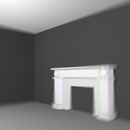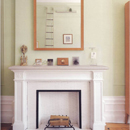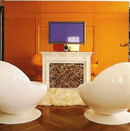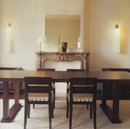
Ghost Hearth
A Ghost Hearth consists of a non-functioning fireplace with a mantel and surround that serve as a decorative wall element. The “hearth” may be original, historic, faux or new. more
Ghost Hearth | Apartment
application
Unless a luxury apartment building is historical, Ghost Hearth is likely to be faux, an appropriation of an original historic fireplace that is used as a decorative device or focal element.
research
There are two types of usage of Ghost Hearth in luxury apartments. 1) One is an existing, but not functioning, fireplace in an historic apartment; the historic fireplace is primarily intact with its original mantel and surround. 2) The second type of Ghost Hearth is a new, non-original, or faux fireplace (surround and mantel) that is essentially a decorative wall element. In all cases, there is no thermal function.
Despite technological gains, luxury apartments retained fireplaces in one or two important rooms, but they no longer function thermally. When fireplaces were no longer necessary for heating, the mantelpiece and hearth continued to represent cultural notions of domesticity—warmth, light, and comfort. And other reasons to retain fireplaces emerged—economic status, style, tradition or nostalgia, as well as historic conservation and preservation.
16th-19th Century Mantel Design in Europe and America. Chimneypieces constituted the first interior architectural feature for which 16th century architects turned their attention, and the first for which pattern books were published. The Italians devised a formula for fireplaces that have remained in vogue ever since. The principal form comprised a projecting chimney-breast with a surround to the opening. The area above the opening, on the front of the chimney-breast, was denoted as a site for ornament, either architectural or sculptural in character. The typical grand chimneypiece produced in Europe around 1620 was massive, with a large opening of tall proportions, above which was heaped a wealth of ornament. French architects set about making this feature more compact, and the ornament gradually became better integrated with the structure. To solve the issue of massiveness, many architects set a painting into the chimney breast. French architects in the 17th century introduced a mirror-glass panel between the picture and the mantel opening and began shaping the fireplace surround to project and recede.
In 18th century France, the chimneypiece continued to form a focal point of a room, but it was no longer quite so obtrusive a feature. It began to be integrated with wall composition, although the English and Germans continued to publish pattern books illustrating the mantel piece as a separate design. From the 16th century forward, one pictorial pattern had been irrevocably determined—the wall above the opening became the site of a special feature (a painting or a mirror, for example).
Building on a system of hierarchy in both design and cultural history, mantel designs constituted some of the most important working drawings of American architects. Many form a visual essay of design features suggested in 1868 by English architect and furniture designer, Charles Eastlake, in his widely disseminated book Hints on Household Taste. Eastlake promoted the use of a wooden over-mantel with a long low strip of mirror (about 18" high) and narrow shelves (6" wide, 12" apart) for specimens of old china. Further, he recommended the display of plates upright on their edges and prevented them from slipping off by sinking a shallow groove in the thickness of each shelf—what came to be known as a plate rail. Eastlake's mantel made a shelf a permanent element. Mantel shelves for bric-a-brac in American homes reinforced the notion of the mantel as the site for some of the family's important possessions: "A little museum may thus be formed and remain a source of lasting pleasure to its possessors, seeing that a thing of beauty is a joy forever." During the Arts and Crafts period in the United States, the medieval fireplace was reinterpreted for ordinary bungalows and English and Spanish revival houses.
20th Century Mantel Design and the Ghost Hearth. In America, Revivalist styles, such as Georgian and Colonial continued almost unabated well into the 20th century. In some cases, antique fireplaces were removed from historic houses and installed in rather plain apartment interiors to give the spaces architectural character. In a New York apartment at 666 Park Avenue, decorated in the 1920s by William R. Pearsall, J. Layng Mills and F. Burrall Hoffman, the library’s fireplace was removed from an 18th century London house. Reinstalled in an oval room of an apartment, the Classically detailed mantel is flanked by built-in bookcases, wall moldings, and a large mirrored over-mantel topped with a broken pediment in which an eagle has been placed.
After the Second World War, fireplace technology advanced. Prefabricated electronic and gas fireplaces became the preferred type, because they were quicker and simpler to install, reduced construction costs, and allowed more design options. Whatever its style, period or expression, the fireplace remains a deeply engrained culturally symbolic element.
During the latter-half of the 20th century, fireplaces in houses continued to be significant features. Americans desired them for their cultural meanings, but they also wanted fireplaces in which actual fires could be built. Drawing the family around the fireplace became an important visual icon. Therefore, during the 1950 to 1970 eras, fireplaces in single-family houses were real ones, competing with television screens. New types of fireplaces with modern forms and new materials synthesized industrialism and design. During the 1945 to 1960 period in luxury apartments, fireplaces of any type almost disappeared.
During the 1970 and 1980 decades, the preservation of historic American buildings became a popular practice, which no doubt encouraged the preservation of historic fireplaces and the reinstallation of historic fireplaces in interiors that were contemporary. The National Park Service dubbed this latter practice as “phony historicism”.
Luxury apartment interiors published in trade magazines illustrate the prevalent use of original, non-functioning fireplaces. In historic buildings, the fireplace sometimes lost its original function because of the inefficiency of old fireplaces, such as the inconvenience involved in supplying fuel, difficulty of cleaning, and insufficient heat. The visual comfort and nostalgic associations, however, made the fireplace more important than thermal function.
Many historic preservation projects in the late 20th century included restoration of original historic mantels. One such project was a small, first half of the 19th century, Greek Revival house in Greenwich Village, Manhattan. The firm, Site Environmental Design, respected the historic element by treating the fireplace as an art installation. Artifacts, such as candelabrum and a bust, were added to the mantel shelf. The entire vignette and the wall were painted white. Visually the artifacts, as well as the fireplace opening, surround and mantel shelf, sink into the wall of the living room, creating one of the best examples of Ghost Hearth. “Everything seems to appear and disappear at the same time.”
Another example of an installation comes from interior designer Peter Carlson who found a rare 18th century English wire mantelpiece that was used in gardens for topiary or trailing ivy. He covered the mantelpiece in moss and placed it in a formal interior, further setting the scene with a pair of 18th Italian scones and chairs. His partner, Linda Chase, recognized the mantelpiece’s potential and began reproducing it for a line of wire garden ornaments that include chairs and sofas.
In 1986 interior designer Kathleen Gibson and architect Paul Westlake, Jr. drew from the cultural meaning of a mantelpiece wall elevation when they designed a faux fireplace for the Goodnough Guesthouse in Cleveland Heights, Ohio. The symmetrical organization of the wall includes the requisite elements—painting, mantel shelf, fireplace opening, surround and hearth—and fabricated in appropriate materials—plaster and marble. The installation abstracts the architectural while keeping cultural meaning intact.
21st Century Ghost Hearths. Mix-matching an original historic architectural envelope with contemporary furnishings continues into the 21st century, and Ghost Hearths remain popular practices in Europe, the Americas and Asia.
In 2003 designer Christophe Pillet renovated a Napoleon III era apartment in Paris by combining the Mix Match practice with White Out—an all-white room with all white furnishings. Only the artwork retains color. Elegant moldings, the mantel piece and coffered ceilings contribute to the unique character of the apartment. A large mirror on the chimney breast is strategically placed to heighten the sense of space.
In Seoul, Korea apartments never had fireplaces, but there is evidence that Ghost Hearths are being used to impart architectural character into typically modular, unornamented boxes. For example, the designer of the Daechi Apartments installed a faux fireplace in a wall of the entry space. The fireplace is finished with an antique wood frame, but the opening of the fireplace is closed with brick, making it clear that the fireplace is not functional. A Ghost Hearth in a Seoul apartment may not convey the same cultural meaning as one in Europe or the United States, but it certainly suggests that the entry hall is an important space to receive such an unique (and foreign) element.
In Brazil, designer Brunete Fraccaroli, created a room for watching television by linking a centuries old focal point, the fireplace, with the 20th-century’s most important icon, a tv screen. The opening of the fireplace is entirely closed with the cut-ends of logs. The white marble of the antique fireplace contrasts as a Mix Match with the strong orange color of the laminated mirror and walls and white Italian furniture. The trend to hang a television screen above a fireplace is evidenced in published work, as well as in ordinary residences.
Fireplaces and mantelpieces live on in residential settings as Ghost Hearths. They have benefited from the historic preservation movement, and from artists who make art installations from mantelpieces. When contemporary designers fill a fireplace opening with an interesting and/or textured material, such as the Sao Paulo example, they are reiterating a Victorian custom of filling or covering a fireplace opening decoratively.
end notes
- 1) Jan Jennings, Cheap and Tasteful Dwellings: Architectural Competitions and the Convenient Interior, 1879-1909 (Knoxville, Tenn.: University of Tennessee Press, 2005), 178-180.
- 2) Peter Thornton, Authentic Décor: The Domestic Interior, 1620-1920 (New York: Viking, 1984), 15, 30-31, 32, 51, 54.
- 3) Jennings, Cheap and Tasteful Dwellings, 180.
- 4) Charles L. Eastlake, Hints on Household Taste: The Classic Handbook of Victorian Interior Decoration (London: Longmans, Green and Co., 1878), 136.
- 5) Encarna Castillo, Fireplaces: Architecture and Design (New York: Harper Design International, 2004), 23-25.
- 6) Library, Seton Porte Apartment [1929] Park Avenue, New York City in Andrew Alpern, New York’s Luxury Apartments: With Original Floor Plans from the Dakota, River House, Olympic Tower and Other Great Buildings (New York: Dover, 1975), 124-129.
- 7) Castillo, Fireplace, 23-25; Henry J. Kauffman, The American Fireplace: Chimneys, Mantelpieces, Fireplaces and Accessories (Nashville, T. Nelson, 1972), 175.
- 8) Kauffman, The American Fireplace, 175.
- 9) Calloway, Twentieth-Century Decoration, 362.
- 10) Matteo Vercelloni, Urban Interiors in New York (Milano: Edizioni l’Archivoloto, 1996), 178-187.
- 11) Montse Borras, "Apartment on Rue Rivoli," The New Apartment: Smart Living in Small Spaces (New York: Universe Publishing, 2007), 149.
- 12) Jeong Ji-seong, Apartment and Villa (Seoul: CAPress, 2003), 76.
- 13) Robyn Beaver, "Color and Light," 50 of the World's Best Apartments (Australia: Images Publishing Group, 2004), 90.
- 14) 1980 Living Room, [1985] Site Environmental Design; Greenwich Village, New York City in Matteo Vercelloni, Urban Interiors in New York (Milano: Edizioni l’Archivoloto, 1996), 178-187; Living Room, Goodnough Guesthouse [1986] KGibson and P. Westlake; Cleveland Heights, Ohio; unpub. / 1990 Installation, English Mantelpiece [bef 1992] Peter Carloson; London, England in Alexandra Edwards, Fireplaces (San Francisco: Chronicle Books, 1992), 21; Apartment [1990] Peter Stamberg & Paul Aferiat Architects; New York City in Matteo Vercelloni, Lofts and Apartments in New York (Milano: Edizioni l’Archivolto, 1999), 200; Alex Verhoustraeten Apartment [c1998] John M. Hall; Brussels, Belgium in Abby Bussel, “Living Large,” Interior Design 69, no. 10 (Aug. 1998): 125 / 2000 Living Room, Napoleon III–Era Apartment [2003] Christophe Pillet; Paris, France in Montse Borras, "Apartment on Rue Rivoli," The New Apartment: Smart Living in Small Spaces (New York: Universe Publishing, 2007), 149; Entry Hall, Daechi Apartment [bef. 2003] Home & Deco Interior Co. Ltd., Seoul, Korea in Jeong Ji-seong, Apartment and Villa (Seoul: CAPress, 2003), 76; Living Room [unknown date] Brunete Fraccaroli; Sao Paulo, Brazil in Robyn Beaver, "Color and Light," 50 of the World's Best Apartments (Australia: Images Publishing Group, 2004), 90.
bibliographic citations
1) The Interior Archetypes Research and Teaching Project, Cornell University, www.intypes.cornell.edu (accessed month & date, year).
2) Kim, Najung.“Theory Studies: Archetypical Practices of Contemporary Luxury Apartment Design.” M.A. Thesis, Cornell University, 2009, 128-141.



